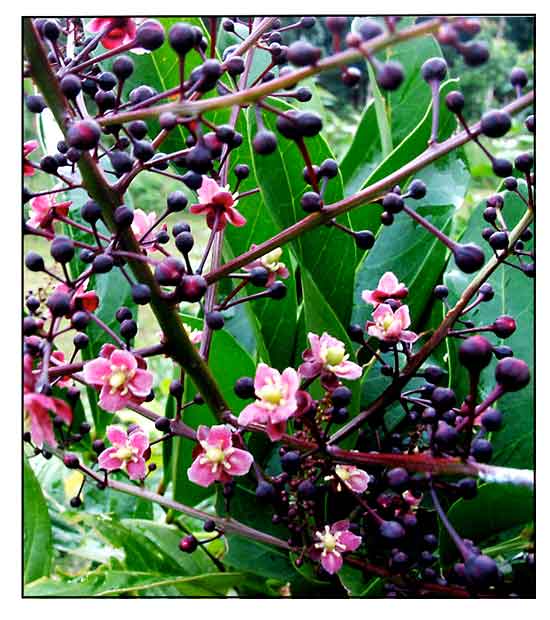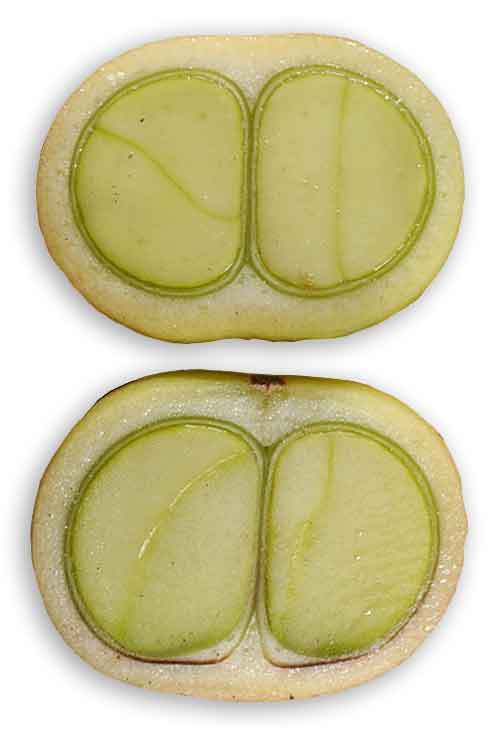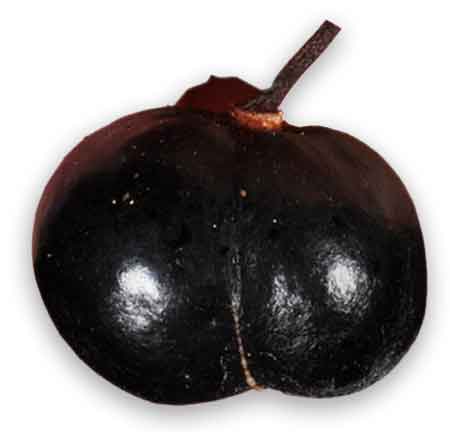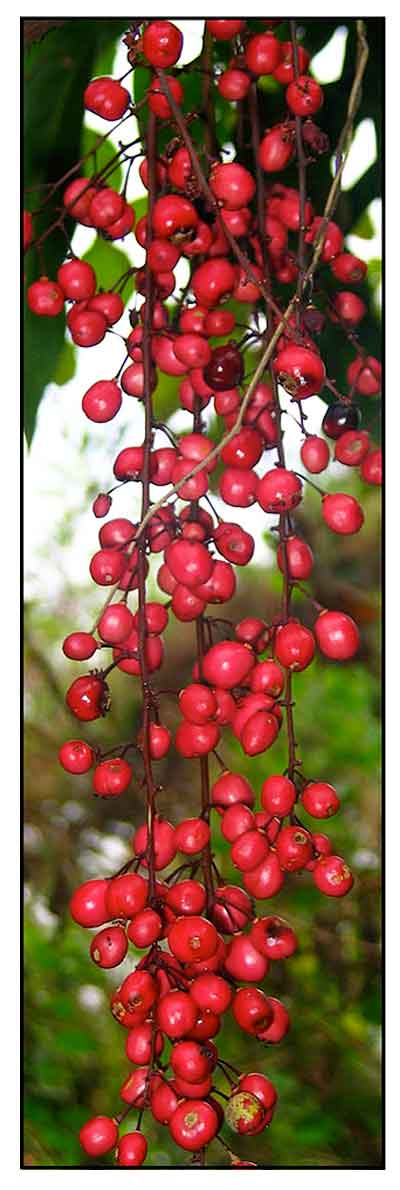 Gen info Gen info
- Lepisanthes is a genus of 24 or 25 species of trees or shrubs native to tropical Africa, south and southeast Asia, Australia, and Madagascar. (3)
- Six species are widely utilized in traditional and folk medicinal
systems: Lepisanthes alata, L. amoena, L. senegalensis, L. fruticosa, L. rubiginosa, and L. tetraphylla.
-
Etymology: Lepisanthes is Latin for 'shrub-like'.
Botany
• Shrub or tree, 1.5-10(-15) m high, dbh 2-15 cm. Leaves without or sometimes with a rather strongly reduced terminal leaflet, 1-8(-14 1-jugate, 25 cm to more than 1 m long, mostly glabrous; Inflorescences (terminal or) axillary to rami- or cauliflorous, solitary or (if cauliflorous) sometimes some together, simple or branched either with some to several ascending long branches from near the base or all over and pyramidal, up to 75 cm long, glabrous; Flowers scentless. Sepals 4-5, outer 2 sometimes smaller, elliptic, orbicular, or obovate, 2-4 by 1.5-3 mm, dark red (rarely yellow to white), margin, especially of the inner ones, petaloid, crenulate to fimbriate-ciliolate, glabrous or very sparsely glandular-ciliolate. Petals 4-5, short-clawed, blade broad-ovate or elliptic to obovate, 1.5 -3 by 1-2 mm, dark red (rarely yellow to white), glabrous or rarely claw ciliate or outside hairy; Stamens 5-8; Ovary 2-or 3(-4)-celled, glabrous; Fruits ovoid, ellipsoid, subglobular, or transversely ellipsoid, rarely distinctly lobed, 1-3 by 0.6-2 by 0.5-2 cm (fresh up to 4 cm in diam.), apparently white when young, dark red to blackish when ripe; Seeds mostly 2, subglobular to semi-ellipsoid, flattened on the axial side, 8-23 by 6-18 by 4-18 mm, hilum orbicular to lanceolate, up to 6 by 3-4 mm. (Flora Malesiana)
 Distribution Distribution
- Native to the Philippines.
- Also native to Borneo, Cambodia, Jawa, Laos, Lesser Sunda Is., Malaya, Maluku, Myanmar, Sulawesi, Sumatera, Thailand, Vietnam. (2)
- An understorey in undisturbed to slightly disturbed mixed dipterocarp, keranga and submontane tropical forests up to 1,400 m altitude.
Constituents
- LC-ESI-MS/MS of fruit pulp extract identified epigallocatechin‑catechin, epigallocatechin, epicatechin, catechin, cyanidin rutinoside, procyanidin trimer, rutin, myricetin rhamnohexoside, luteolin glucoside and its derivative which were from the flavonoid group. GC-MS/MS identified fatty acids and sterols. (see study below) (6)
- LC-MS/MS analysis of fruit seed extract showed presence of phytochemicals with antidiabetic properties with
α-kojibiose, genistein-7,4'-di-O-β-D-glucoside and soyacerebroside II as predominant ones. (see study below) (10)
- Study of ripe fruit for total phenols yielded 0.48
g of gallic acid / 100 g dried fruit and 0.77 g gallic acid / 100 g extract.
Properties
- Results suggest antioxidant, antidiabetic, anti-Dengue and anti-West Nile Virus inhibitory, prebiotic, antibacterial properties.
Parts used
Roots, leaves.
 Uses Uses
Edibility
- Fruits are edible; sweet with slight tartness when ripe.
- Seeds are edible; roasted, with a chestnut flavor.
- In Thailand, young leaves cooked as vegetable.
Folkloric
- The Kanawan Aytas in Morong, Bataan, apply the leaves directly to the area of back pain. (11)
-
Root used in a poultice compound to relieve itching and fever.
- Kedayan in Sarawak use tea infusion of root for treatment of rheumatism and impotence. Tea made from roots and roots of pasak nagi is drank to relieve backache and enhance sexual desires. (13)
- Root used as antipyretic; ripe fruit used as antidiarrheal. (12)
Others
- Wood: Hard, heavy, and durable; used for house construction.
- Ritual: In Thailand, shoots used in a preharvest rice ritual. (13)
 Studies Studies
• Toxicity Study / Fruits: Study evaluated the toxicity of L. fruticosa fruit extract using a 28-day repeated-dose oral toxicity method on female Sprague Dawley rats. The extract did not cause any negative hematological effect, no liver or renal changes, no significant changes in enzymatic and blood parameters, and no effect on normal body functions.. The extract was found safe at high dose of 3000 mg/kg without mortality or toxicity symptoms. (4)
• Antidiabetic / Antioxidant / α-Amylase and α-Glucosidase Inhibitory Activity / Pulp and Seeds: Study evaluated invitro antioxidant, α-glucosidase and α-amylase inhibitory activities of crude extracts and fractions from L. fruticosa pulp and seeds of unripe fruit. The ethanolic seed extract and fraction M4 exhibited strongest radical scavenging, ß-carotene bleaching activity, α-glucosidase inhibition and highest total phenolic content. Results suggest an excellent source of bioactive phytochemicals with antioxidant and antidiabetic potential. (5)
• Anti-Dengue and West-Nile Virus / Pulp: Study evaluated the inhibitory activity of Lepisanthes fruiticosa pulp extract against NS2B-NS3 proteases from DENV2 and WNV. The extract exhibited inhibitory activity toward DENV2 and WBV NS2B -NS3 proteases with 50% inhibitory concentration value of 1.733 and 9.245 mg/ml, respectively. Results suggest a potential source antiviral. Pulp metabolites such as groups of flavonols, flavones, and sterols may contribute to the inhibitory properties. (see constituents above) (6)
• Antioxidant / Fresh and Freeze-Dried Fruits: Study evaluated the antioxidant and phytochemical attributes of fresh (FLF) and freeze-dried (FDLF) L. fruticosa fruits at eight different maturity stages. The lower maturity (unripe) stages exhibited the strongest potential, with stage 1 the most notable. The FDLF fruit extract showed significantly (p<0.05) stronger radical scavenging at all maturity stages. IC50s of FDLF for the 8 stages were more effective, with stage 1 showing lowest IC50 of 1.57 mg/ml. Phenolic content was significantly higher (p<0.05) than FLF at all 8 stages. The FLF showed significantly higher (p<0.05) total flavonoid content at all stages except 2, 3, and 6. Results indicated antioxidant and phytochemical contents are significantly affected by processing and maturity, and suggest potential for fruit extracts as natural antioxidant in functional food production. (7)
• Effect of Pretreatment and Ripening Stage on Nutrient and Antioxidant Properties / Whole Fruit Powder: Study evaluated the effect of pretreatment (blanching and steam) and ripening stage (ripe and unripe) on nutrient content and antioxidant properties of whole fruit powder. Blanching and steaming significantly affected (p<0.05) fat content, vitamin C. total anthocyanins and antioxidant activity regardless of ripening stage. Blanching lowered the fat content and enhanced antioxidant activity. On ripening, protein and ash content decreased. Vitamin C showed increment of more than 80% in the ripe sample. Antioxidant was higher in the unripe sample, although both stages showed EC50s of ≤ 1 mg/mL. Results suggest both stages of fruit have potential as functional ingredient with high dietary fiber. (8)
• Prebiotic Properties / Antibacterial / Beverage: Study evaluated the survival of lactic acid bacteria (LAB) in fermented ceri Terengganu (L. fruticosa) beverage and its antibacterial activity. Five selected strains of LAB were Bifidobacterium bifidum UABb-10™, Lactobacillus acidophilus DDS®-1, Lactobacillus paracasei UALpc -04™, Lactobacillus plantarum UALp-05™, and Streptococcus thermophilus UASt-09™. Listeria monocytogenes ATCC® 51772TM, Salmonella enterica serovar Enteritidis MDC15, Salmonella enterica serovar Typhimurium ATCC® 53648TM and Streptococcus gallolyticus ATCC® 9809TM were selected to determine the antibacterial activity. Antibacterial activity using agar well diffusion method inhibited five tested food-borne pathogens with inhibition zones ranging between 12.92 and 18.50 mm diameter. Broth microdilution method showed 100% inhibition of fermented ceri Terengganu beverage against the test microorganisms. Results suggest potential as a prebiotic beverage and might be able to reduce risk of food poisoning with its good antibacterial effect against foodborne pathogens. (9)
• Antidiabetic / Antioxidative / Seed: Study evaluated the invivo antidiabetic and antioxidative effects of L. fruticosa fruit seed extract in a high-fat diet, streptozotocin-induced Sprague Dawley rats using doses of 300 and 600 mg/kbw. The high dose of 600 mg/kbw showed more pronounced anti-hyperglycemic effect in both acute and subchronic studies. There was 40% improved serum insulin level, a significant (p<0.05) 20% increase in superoxide dismutase (SOD) and 43% increase in catalase (CAT) activities, and a significant (p<0.05) 28% decrease in lipid peroxidation. Results suggest the fruit seed extract has potential in reducing hyperglycemia and enhancing antioxidant status in HFD/STZ-induced diabetic rats. The fruit may be a promising candidate for a new and safe alternative remedy for prevention and treatment of type 2 diabetes. (see constituents above) (10)
Availability
- Wildcrafted.
- Cultivated.
- Plants in the cybermarket.
|

![]()




 Distribution
Distribution

